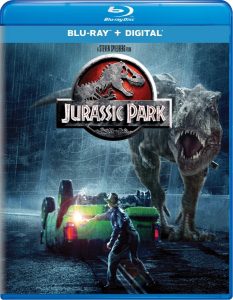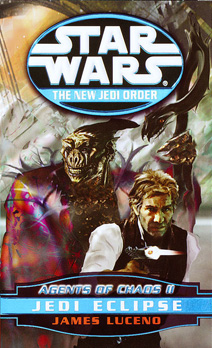“Agents of Chaos I: Hero’s Trial” was James Luceno’s salute to Brian Daley, packed with old-school Han Solo adventuring. “Agents of Chaos II: Jedi Eclipse” (2000) – the fifth book in the “New Jedi Order” series – is more of a compromise between Daley-style fun and the overall dark direction of the “NJO” saga.
Once again, Luceno strikes a masterful balance between referencing old stories and making sure they fit with the flow of the current story. We get “Wow, it’s a small galaxy” experiences without losing the feeling that it’s a gigantic galaxy where a person could purposely disappear from the hustle and bustle if they really wanted to.
For example, Han and Droma are chased through a grain field by a corrupt agricultural corporation on the planet Ruan. This has definite echoes to a similar chase in “Han Solo at Stars’ End,” but Luceno doesn’t make overt reference to it. Also on Ruan, Han meets a droid named Baffle, whom he initially mistakes for Bollux because he is the same model. And later, on Fondor, one might think we’d run into Tanith Shire, especially since Luceno name-dropped her in the previous book, but we do not.
When dealing with galactic politics and war, though, it makes sense that the bigger movers-and-shakers would pop up again. Most intriguingly, Luceno brings the threads from Roger MacBride Allen’s “Corellian Trilogy” back into play here. While the writing of that trilogy was mediocre, it did introduce some fascinating ideas, and I welcomed their return. Admittedly, I didn’t even remember if Han’s twisted cousin, Thrackan Sal-Solo, had survived the “Corellian Trilogy,” but his return provides some juicy philosophical discussion on page 265:
Again (Thrackan’s) glance favored Anakin. “I have you to thank personally for banishing our illusions of a free and independent Corellia. But, tell me, do you still think we were wrong to make a grab for freedom?”
“Your methods were wrong,” Jacen said before Anakin could respond.
Jacen is understating the situation, as MacBride Allen did not present Sal-Solo with any nuance: Rather than a freedom fighter who got into some gray areas, Thrackan was consistently a speciesist power monger who stirred up political foment for his personal gain. In other words, yes, Corellia has a moral right to independence and the New Republic has no moral ground to stop that. But no, Thrackan himself is not a true freedom fighter.
By the end of “Jedi Eclipse,” Thrackan – despite firing Centerpoint Station’s repulsor weapon and killing three-fourths of the fleet of the Hapans, crucial New Republic allies – is again in political power, using the Corellia system’s independent streak for his own gain. Corellia’s desire for independence will come to the fore again in the “Legacy of the Force” series. And one of the saga’s great ongoing mysteries at this point, the origin of Centerpoint, will be revealed in the “Dark Nest Trilogy.” For now, Luceno does a nice job of keeping those threads prominent.

Authors’ knowledge of past stories are crucial in the “NJO” so readers don’t say “Well, why didn’t they just do this instead of that?” That might be a big reason why “Jedi Eclipse” finds Leia recruiting Prince Isolder (introduced in “The Courtship of Princess Leia”) and the Hapan military. Centerpoint’s repulsor beam ends up slaughtering three-fourths of the fleet and encourages the rest to scurry back to the Hapes Cluster. But at least the saga has now addressed the concept of the New Republic trying to team up with Hapes, just as it made inroads with the Imperial Remnant in the “Dark Tide” duology. (Next up, the New Republic really needs to check in with the Bakuran Navy, in my opinion, as they were crucial allies in the “Corellian Trilogy.”)
The thread that really comes to the fore in “Jedi Eclipse,” though, is the idea that the galaxy does not trust the Jedi anymore, as they have been wrongly blamed for mistakes such as the Centerpoint incident while also being (perhaps somewhat fairly) criticized on other fronts for being too passive about fighting the Yuuzhan Vong. On a personal level, the conflict between aggressive fighting and passive defense continues to play out between Anakin and Jacen. Indeed, Anakin wants to fire Centerpoint’s weapon but backs down when his older brother tells him not to (Thrackan then takes over and fires the weapon with less accuracy than Anakin would have).
It’s interesting that the galaxy’s view of the Jedi – and the political maneuvering, particularly by Borsk Fey’lya, to discredit the Jedi – precisely parallels what George Lucas would later do in “Episode III: Revenge of the Sith” (2005). And the Solo brothers’ debate parallels the debate between Anakin Skywalker and Obi-Wan, which first came to prominence in “Episode II: Attack of the Clones” (2002). These are delicious bits of (probably coincidental, but maybe not entirely) synergy, and we’ll see more examples as the “NJO” saga moves forward in a real-time parallel with Lucas making the prequel films.

